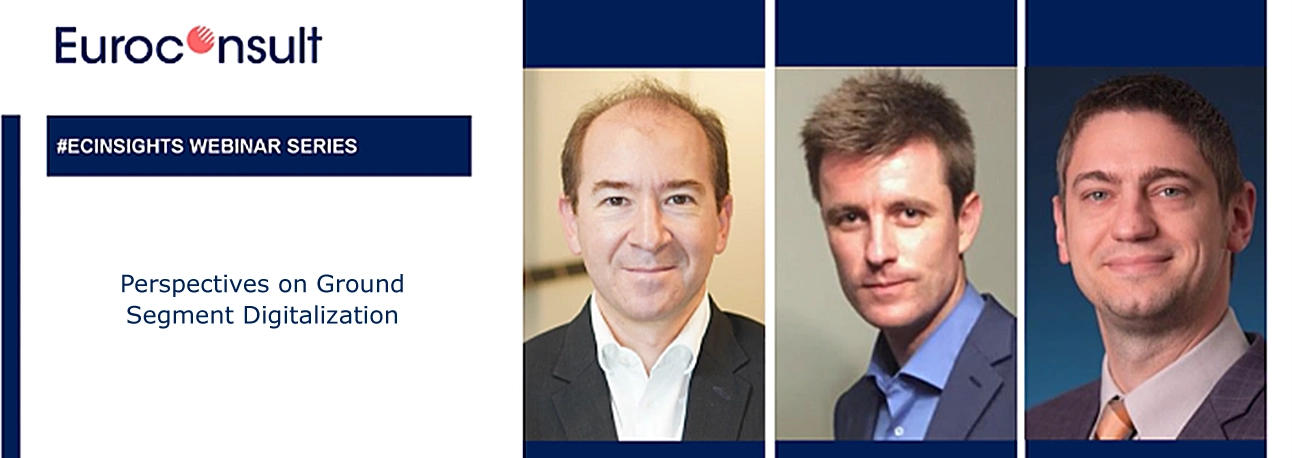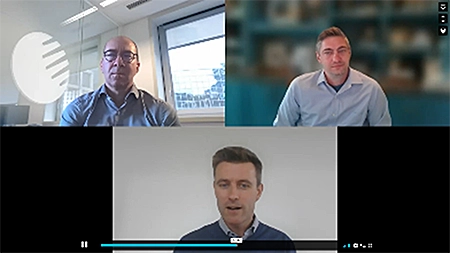One of the hot topics for the satellite industry at the moment is the cloud. But what do we, as an industry have to do to make satellite-based cloud a reality?
The transition to the cloud will involve the virtualization of physical hardware to software, seeing an end to the familiar sight of endless racks of boxes in data centers. It will mean that access to the cloud can happen anywhere and that users will have access to services and applications instantly via a software-based environment. It’s a process that will take time, but concrete steps are well underway to make it happen.
We brought together three leading industry figures: Euroconsult CEO, Pacome Revillon, Microsoft Azure’s Paul Tilghman and our own Frederik Simoens, to take a deeper dive into some key areas that will enable the digital transformation of the ground segment.
Identifying key disruptors
The trio kicked off by taking a closer look at the key disruptors in the satellite sector. Pacome pointed out that ‘software defined’ isn’t just the current buzzword in the industry – it’s also reality. Over the last year, more than 70% of GEO satellite orders were of so-called software defined payloads and GSO broadband constellations. Operators want to build satellites that don’t just offer volume but flexibility. They need to offer options for dynamic allocation and integration with terrestrial networks in order to provide a seamless and high-performance end-user experience. That’s not easy to achieve.
However, changes in customer requirements among satellite companies and in the ICT environment, are pushing the satellite connectivity industry to reinvent itself to maintain its relevance, increase its addressability and build new economics for the sector. Digitization, in the sky and increasingly on the ground, appears to be the way forward for new forms of value creation.
What advances are being made in virtualization and cloudification of satellite ground networks?
Paul explained that cloud isn’t just a megawatt class data center. It also extends to the edge, to the ground segment itself and to compute infrastructure. This is known as hybrid cloud and it’s more than just infrastructure.
Frederik confirmed that the biggest shift for the space industry is that we’re moving from a model that has been around for decades where the technology providers deliver equipment which our customers then host and build a service around. This model is changing. Instead, virtualized technology will be delivered to customers and will run on cloud infrastructure rather than infrastructure that they host themselves. Partners like Microsoft will deliver this cloud infrastructure. ST Engineering iDirect’s customers can then focus on providing end-to-end connectivity and the best quality of service to their customers.
Frederik and Paul both elaborated that in such a scenario, Service Providers would have immediate access to a range of new services in the cloud domain, such as AI and other tools to manage networks, which can be leveraged as add-ons when making that transition.
Paul also drew comparisons with the rapid transition that the terrestrial wireless community has gone through over the last decade. This occurred primarily in telco data centers and telco edges to compute infrastructure and, as an industry, we have benefitted from lessons learned at that time. Microsoft hopes to apply these lessons and technologies into the satellite market to help enable the space segment to go through that same transformation.
Standardization for better interoperability
Frederik confirmed that the biggest advantage of leveraging the cloud is added flexibility. It’s important to be able to adjust the business case as applications and coverage changes. For this reason, Frederik believes that it is important to have a more standardized approach and the ability to become more embedded with terrestrial networks. Both Microsoft and ST Engineering iDirect have been involved in 3GPP or DIFI interoperability consortia to make this happen.
Frederik went on to explain that there are several important aspects to standardization. One is the cost. Standards achieve economies of scale. Without this, software is just as expensive as hardware. Virtualization isn’t a panacea in itself without standardization. Until now, satellite VSAT systems have been managed as standalone systems. Today, this is changing as some of the terrestrial standards are becoming dominant, such as the 5G/ 3GPP and the MEF standards. The use of standards will allow service providers to integrate satellite communication systems into an existing terrestrial environment that can be easily managed as one, further aligning the operations. One very important step in the right direction is 3GPP’s recent release 17. The 3GPP standard is a really good example of how terrestrial and non-terrestrial telco is blending and how support for non-terrestrial networking is coming out of these larger terrestrial standards bodies.
There was also agreement between Frederik and Paul that if we standardize, we need to have one single standard. For example, the DIFI standard means that the industry must have a common understanding of how RF signals will be digitally transmitted when a modem runs on dedicated hardware or runs virtualized in the cloud. At ST Engineering iDirect, we are adopting this standard as part of our modem and hub architecture.
Virtualization: Proving concepts through partnership

Paul acknowledged that one of the most challenging elements of moving satellite to the cloud, is virtualizing modems, that is, converting something that is traditionally a hardware appliance in a satellite communications network, into software.
For example, we have been working on the abstraction of the software modem functionality from the hardware and last month Azure and iDirect demonstrated an important milestone. We showcased how a virtualized modem running as containerized software on a commercial-off-the-shelf server in the Azure cloud can now demodulate high data-rate satellite signals.
Paul went on to explain how a fully virtualized modem would allow Azure to use the cloud to orchestrate it, that is, load and provision it, both to the remote site and the satellite ground station in a hybrid cloud just as though it were an element in a hyperscale data center. He went on to explain that elasticity is a key concept in such a cloud construct. In a service-based architecture, if you’re not using resources, they can contract and return to the resource pool if you have a service-based architecture. He acknowledged that ST Engineering iDirect is already tackling this requirement. The cloud is a service platform that can be easily and rapidly built upon so that a customer can layer up their services. Everything is virtually deployable in the cloud. Customers can quickly proceed from a core layer to a very complex enterprise network architecture by deploying additional services on top of this virtualized ground segment in the cloud.
What will the future cloud look like?
Paul mentioned that in a few years the environment will look very different. Paul and Frederik both made a bold prognosis: In the future, the ground segment will operate in a cloud native network of some kind which can be deployed in the hyperscale cloud involving scalable cloud computing systems with massive numbers of servers connected to a network. Servers can be increased or decreased according to the needs of a network and as performance requirements demand. The Microsoft Azure platform abstracts where the network functions are deployed so they reach all the way to the edge.
Want to hear the full webinar for yourself?
Watch the conversation in its entirety to gain more insight into the potential of the cloud and how our partnership with Microsoft is helping to shape satellite’s future in this pivotal technology. And read this whitepaper to find out more about the industry’s transition to the cloud.

